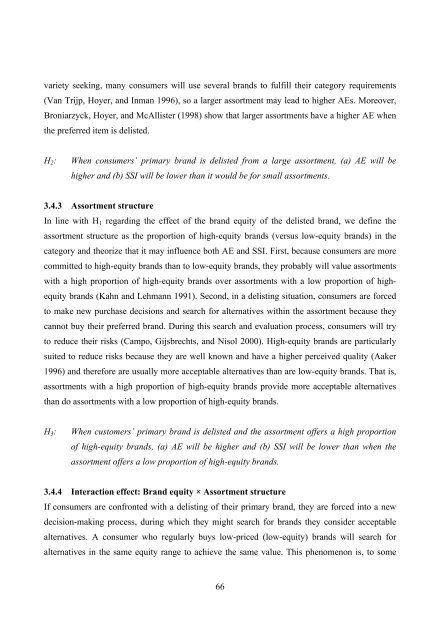Understanding Consumer Reactions to Assortment Unavailability
Understanding Consumer Reactions to Assortment Unavailability
Understanding Consumer Reactions to Assortment Unavailability
Create successful ePaper yourself
Turn your PDF publications into a flip-book with our unique Google optimized e-Paper software.
variety seeking, many consumers will use several brands <strong>to</strong> fulfill their category requirements<br />
(Van Trijp, Hoyer, and Inman 1996), so a larger assortment may lead <strong>to</strong> higher AEs. Moreover,<br />
Broniarzyck, Hoyer, and McAllister (1998) show that larger assortments have a higher AE when<br />
the preferred item is delisted.<br />
H2: When consumers’ primary brand is delisted from a large assortment, (a) AE will be<br />
higher and (b) SSI will be lower than it would be for small assortments.<br />
3.4.3 <strong>Assortment</strong> structure<br />
In line with H1 regarding the effect of the brand equity of the delisted brand, we define the<br />
assortment structure as the proportion of high-equity brands (versus low-equity brands) in the<br />
category and theorize that it may influence both AE and SSI. First, because consumers are more<br />
committed <strong>to</strong> high-equity brands than <strong>to</strong> low-equity brands, they probably will value assortments<br />
with a high proportion of high-equity brands over assortments with a low proportion of high-<br />
equity brands (Kahn and Lehmann 1991). Second, in a delisting situation, consumers are forced<br />
<strong>to</strong> make new purchase decisions and search for alternatives within the assortment because they<br />
cannot buy their preferred brand. During this search and evaluation process, consumers will try<br />
<strong>to</strong> reduce their risks (Campo, Gijsbrechts, and Nisol 2000). High-equity brands are particularly<br />
suited <strong>to</strong> reduce risks because they are well known and have a higher perceived quality (Aaker<br />
1996) and therefore are usually more acceptable alternatives than are low-equity brands. That is,<br />
assortments with a high proportion of high-equity brands provide more acceptable alternatives<br />
than do assortments with a low proportion of high-equity brands.<br />
H3: When cus<strong>to</strong>mers’ primary brand is delisted and the assortment offers a high proportion<br />
of high-equity brands, (a) AE will be higher and (b) SSI will be lower than when the<br />
assortment offers a low proportion of high-equity brands.<br />
3.4.4 Interaction effect: Brand equity × <strong>Assortment</strong> structure<br />
If consumers are confronted with a delisting of their primary brand, they are forced in<strong>to</strong> a new<br />
decision-making process, during which they might search for brands they consider acceptable<br />
alternatives. A consumer who regularly buys low-priced (low-equity) brands will search for<br />
alternatives in the same equity range <strong>to</strong> achieve the same value. This phenomenon is, <strong>to</strong> some<br />
66

















